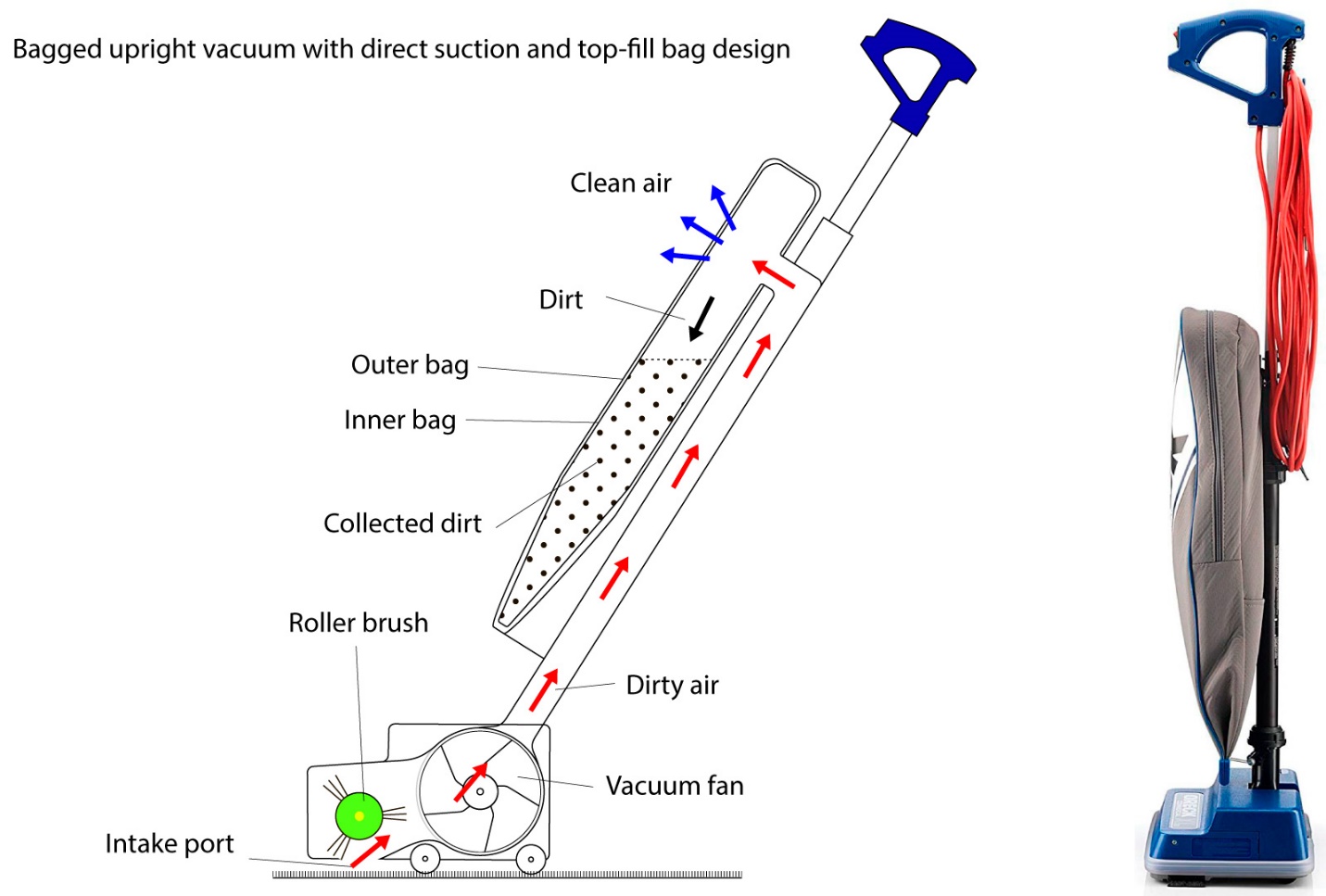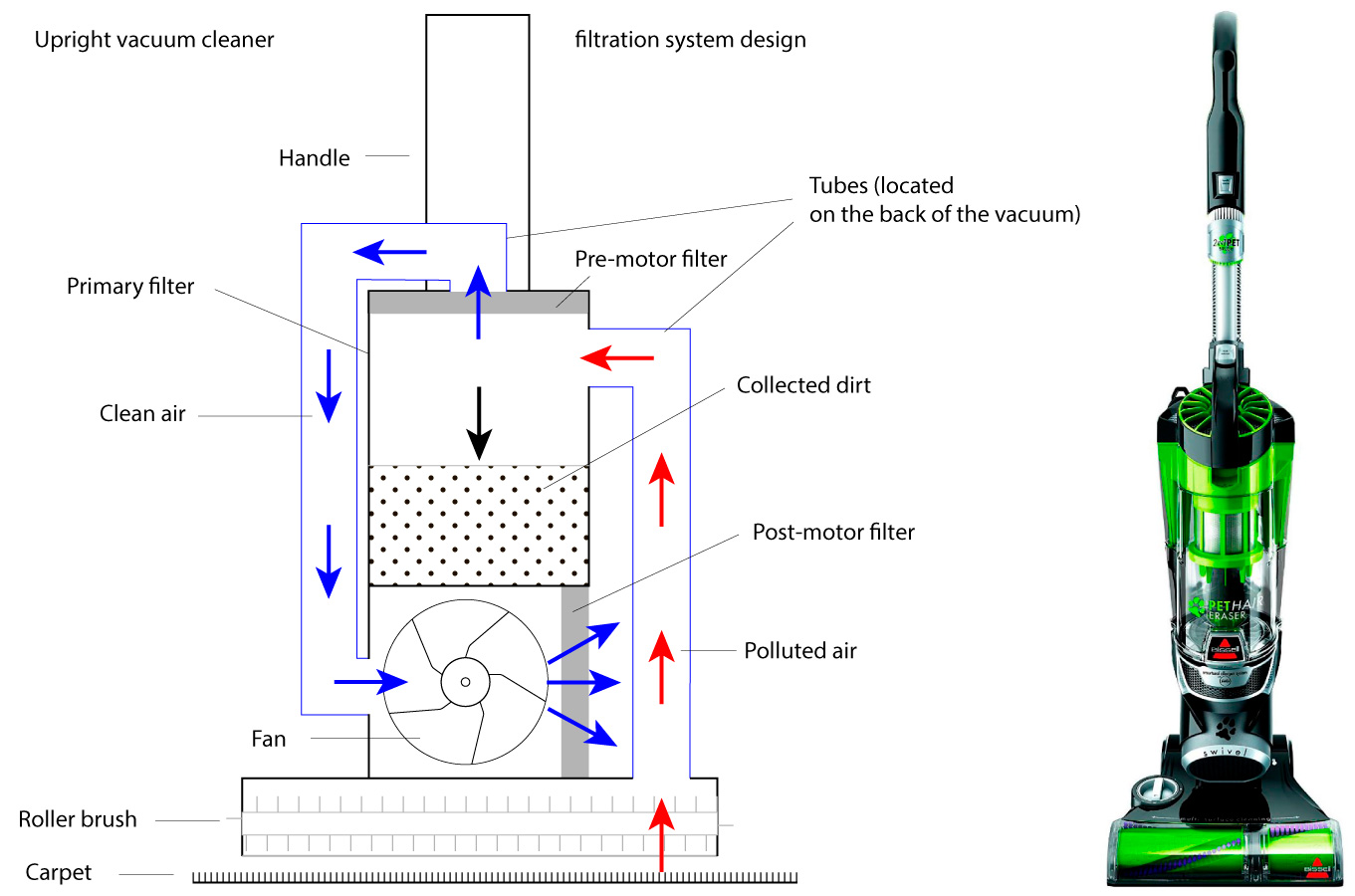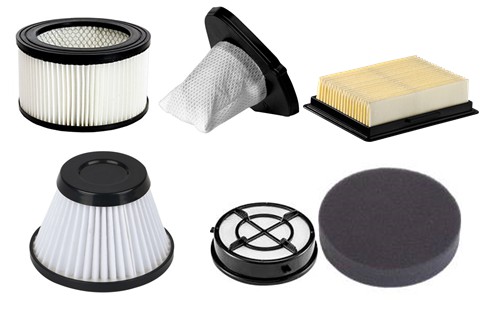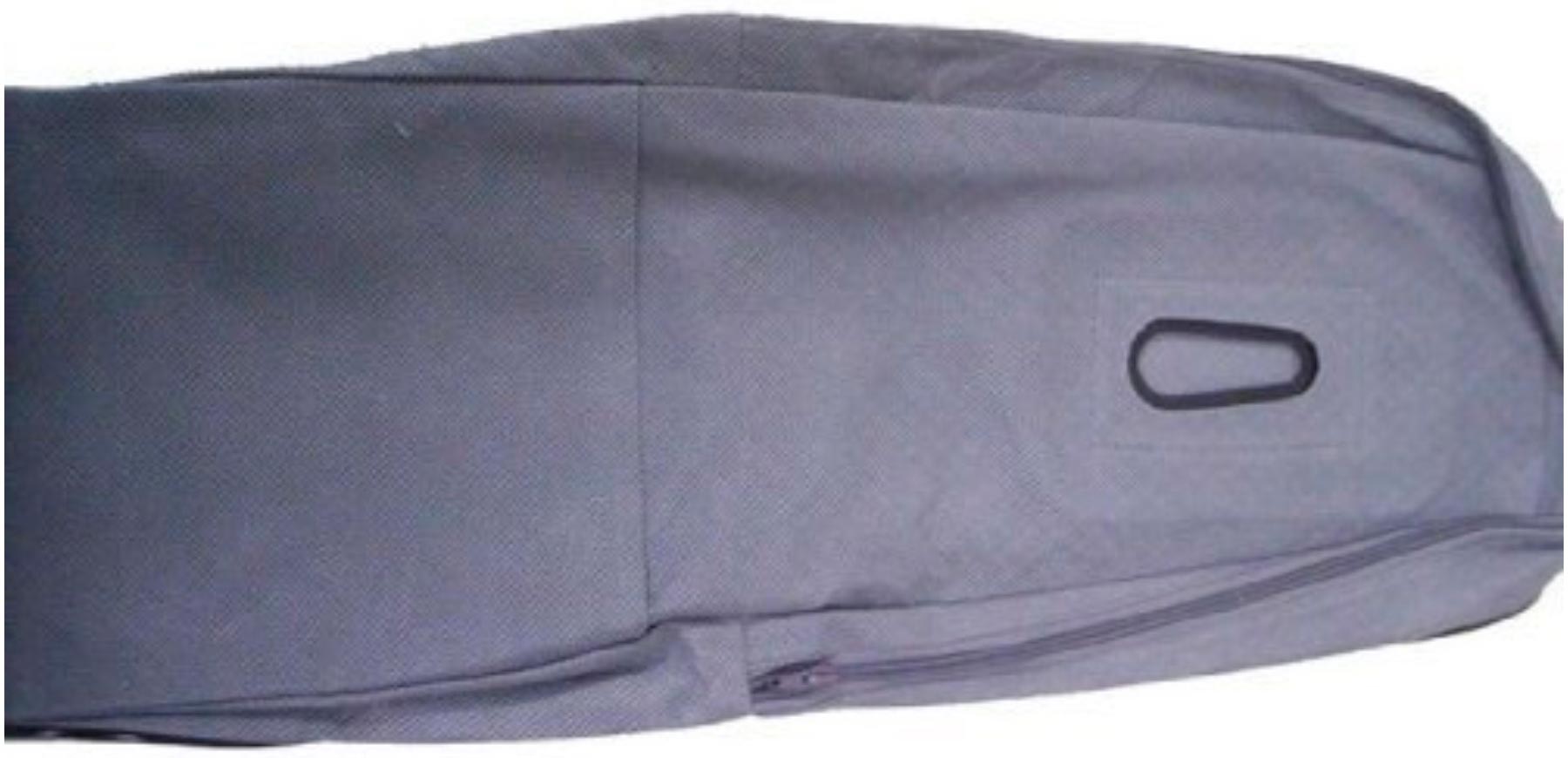To keep sucked dirt and debris inside and allow the clean air to escape, all the vacuums have a filtration system. Bagged models use bags for primary filtration while the bagless models have a dustbin and use either a filter inside the bin or cyclonic action to separate dust particles from the air. When there is some dirt inside the bin, mechanical filters can get clogged, which causes suction loss, while cyclone keeps suction on nearly the same level. People who suffer from respiratory ailments are going to find a greater benefit to having a vacuum featuring HEPA filtration, which removes 99.97% of particles 0.3 micrometers in size.
Filtration System Purpose
All vacuums need a filtration system so that air can circulate through the machine and back into the environment while keeping the dust trapped inside the unit. This prevents particles from escaping into the air and alleviates health issues. Fine dust in the air is harmful to humans, especially to those suffering from asthma, allergies and other respiratory diseases.
Mechanical Air Filter
Every vacuum cleaner utilizes one or several mechanical air filters. These are the least complex type of filter and work much like a sieve. Made of a porous material, it will have holes to trap particles that aren’t wanted in the air but will have smaller holes that allow the air back through.
An issue is that the mechanical filters inevitably exhaust in the room’s air the fine dust – dust finer than size of their pores. To limit the fine dust being exhausted, vacuum manufacturers create filters with smaller pores.
Nevertheless, the smaller are pores the higher resistance for airflow the filter creates. Even brand new they restrict cleaner’s suction power, and gradually they become clogged by fine dust that lowers suction power even more. That’s why it’s important to replace (or wash for washable models) filters regularly.
To compensate filter’s resistance for airflow, vacuum requires a more powerful motor. And the more efficient is filter, the more powerful motor is needed.
Filtration System Design
Most vacuums feature several stages of filtration. A vacuum will contain either a bag or a dustbin. This is the primary filter in the vacuum.
Direct suction
In bagged upright vacuums with direct suction, inner bag is usually placed in another, outer bag, which serves as a secondary filter. The fun sucks dirt from the floor through a nozzle with very short tube and blows it to the inner bag. Dirty air goes directly through the fan. The dirt stays in the inner bag while the air goes through the pores of the inner bag first and then through the outer bag back into the room. The outer bag traps more fine dust that was able to escape through the inner bag.

Indirect suction
In all the other models secondary filters are a pre-motor filter and a post-motor filter, otherwise known as an exhaust filter. The fan sucks dirt from the floor through a nozzle, primary filter and a pre-motor filter and blows it back to the room through a post-motor filter. Through the fan goes almost clean air.

Bagged Vacuums
If using a bagged vacuum cleaner, the machine’s primary filtration system is the bag itself, which can be made of paper, synthetic materials or cloth. Its purpose is to catch dirt and dust particles, and keep them inside. The clean air is still capable of passing through the pores of the bag.
In upright vacuums with direct suction, bags can have either top-fill or bottom-fill design, depending on location of the tube where dirty air comes from. In top-fill bags dust falls down and collects on the bottom letting the air go over it through the top part of the bag without messing with collected dust. It keeps suction on a high level longer in comparison with bottom-fill design where dirty air blows from the bottom through collected dust, which lowers airflow.
The Benefits of Bagged Vacuum Cleaners
More Hygienic
In a bagged vacuum, the dirt and debris are contained within the bag at all times. This makes it the most hygienic option when looking for a vacuum cleaner. As manufacturers continue to make more technological improvements to vacuums, they become even better at trapping all those allergens safely inside the bag.
When removing the bag for disposal, the dirt continues to remain inside, never escaping into the air. This makes for less mess than a bagless model and assures those allergens never make it back into the environment potentially causing negative health consequences.
Require Less Maintenance
In a vacuum featuring a bag, it won’t need to be replaced as often. Bags are capable of holding up to two pounds of dust and debris and won’t need to be emptied as much as the bagless models.
The Disadvantages of Bagged Vacuum Cleaners
Need to Buy Bags
Every time the vacuum is full, the bag needs to be disposed of. This creates an ongoing expense just so you can clean your home. If you are still using an older model cleaner, you may even have difficulty finding the replacement bags. If you weren’t able to find your bags, you’d have to purchase universal bags that you would have to cut to fit your vacuum cleaner.
Decreased Performance as Bag Fills
As the bag begins to fill, there will start to be noticeable performance issues. The only time that a bagged vacuum runs at its top performance is when the bag is new and empty. It is also quite difficult to tell when the bag is full on older models. When using a newer model, there will often be an indicator light to alert when the bag is full
Bagless Vacuums
Unlike the cleaners with bags, a bagless vacuum features a plastic dustbin that will collect the dirt and debris.
Bagless Vacuum with Traditional Filter
In simple bagless vacuums, primary filter is hard plastic container, dustbin where the dirt will be trapped for easy disposal. It has intake hole for airflow somewhere in the top part of the dustbin and exhaust hole which can be either in the top or in the bottom. Exhaust hole is normally covered with a mechanical filter.
The fan of the vacuum sucks air through the dustbin. When the air stream passes from narrow tube into the wider area of the dustbin, it slows down. This drop in speed effectively loosens the air’s grip, so heavy dirt particles can fall out of the air stream to the bottom of the dustbin and stay here. The air goes toward the fan through the filter, which traps fine dust.
The dust can stuck to the filter and potentially clog it, which creates a loss of suction as the dustbin fills.
Cyclonic Filtration
Advanced bagless vacuums feature cyclonic technology. It is used to separate the dirt from the air and trap the dirt inside the canister. A cyclonic system will not clog easily while maintaining a strong and consistent suction throughout the entire cleaning process.
The dirt bin will be in a cylindrical shape. The air enters in the top corner of the bin and is pushed into a spiral because of the angle that it enters at. This creates a centrifugal force that will make the larger dirt particles to fall out of the stream of air into the bottom of the bin. The air then flows through the filter, which is located in the top of the bin, and more dirt and debris will be removed.
Advantages of Bagless Vacuum Cleaners
Less Expensive
After you pay for the bagless vacuum, the cost of operation and maintenance are going to be less than those of the bagged model. Mainly, the savings comes from not having to purchase bags on an ongoing basis. The dustbin can be emptied continually and should last the entire life of the vacuum cleaner.
Visible Dirt Collection
Most dustbins are transparent which allows the user to see when it is time to empty the dirt. This also comes in handy when something becomes accidentally vacuumed up such as jewelry.
Disadvantages of Bagless Vacuum Cleaners
More Hands-On
To maintain maximum suctioning power, the dustbin must be emptied and filters cleaned on a regular basis.
Exposure to Allergens
While the dustbin is being emptied or the filters are being cleaned, the user will find themselves in contact with the allergens in the dirt and debris. This can be hazardous to health, especially if the operator struggles with allergies or asthma.
Secondary Filters
A secondary filter will ensure that even small dust particles remain inside the vacuum.
There are secondary filters that will take the air through a more extensive filtration process after traveling through the primary filter. This is done before the air escapes back into the room.
Outer bag
In bagged upright vacuums with direct suction, secondary filter is the outer bag. It traps fine dust that escaped through the inner bag so it doesn’t come out of the vacuum.
Pre-Motor Filter
This filter is designed to protect the motor from any small particles that made it through the primary filter.
Post-Motor Filter
These are located where the air will exit the vacuum. It is the final state to ensure that no dirt and dust enters back into the environment after the filtration process.
High-Efficiency Particulate Air (HEPA) Filter
HEPA filter is an extended multi-layered media filter with a rigid casing that encloses the pleats. To meet the standard, a HEPA filter must be able to capture 99.97% of the 0.3-micron particles from the air that is passing through the filter. To put this in perspective, the human hair is approximately 100 micrometers in diameter meaning 300 times the size of the particles that a HEPA filter will trap.
For a user who suffers from allergies, COPD, asthmas or any respiratory ailments, the HEPA filter is an important aspect of creating a healthy home. Airborne allergens, that can generally aggravate these conditions such as animal dander, dust, and pollen will be stopped and removed from the air.
Even without any respiratory issues, the common user will find relief from bacteria, spores, dust, viruses, and pathogens simply by using this filter. Keep in mind that vacuums which state things like, “HEPA-like” or “HEPA-style” are not held to the same strict standards of a HEPA filter. The “anti-allergen” label is not the same thing as a HEPA filter.
Usually HEPA filter is post-motor.
A HEPA filter is going to slow the air stream in a vacuum and it does require more suction to get the air moving past the fibers of the filter. This is why a cleaner, which features HEPA filtration, must have a more powerful motor; otherwise, it may not provide an adequate cleaning job.
Completely sealed HEPA system
To provide the most effective filtration, the vacuum with HEPA filter needs to be a sealed unit. This means that the air is forced through the filter and not allowed to escape. The bag and motor components of the sealed unit will have rubber gaskets to ensure the capture of all dust-filled air. This keeps the allergens safely in the machine where they belong.
Keep in mind that HEPA media filtration is not the same thing as sealed HEPA filtration.
Filter Maintenance
When looking to extend the life of a vacuum cleaner, it is imperative to have a clean filter. When dealing with a clogged filter, it is easy to notice that the unit will have less suction.
Having a full primary or pre-motor filter will also result in dust and debris making its way into the workings of the cleaner making for a shorter machine life.
Note that when we are speaking about fill bag or dustbin we don’t mean it’s completely filled with dust so there is no free space at all. We mean it’s full up to the full mark for the transparent dustbins or the suction decreased significantly.
Disposable Filters
When using a unit with disposable filters, keep in mind that there will need to be a purchase of more filters when they are clogged. The upside to this is that the vacuum gets brand new filters every time they are replaced.
Washable Filters
The benefit to having washable filters is that they don’t need to be replaced when dirty. They are easily washable and reusable. This is convenient, but washing a filter will usually remove the surface particles, leaving behind the particles which are stuck to the filter’s fibers.
The loose surface particles are going to collect inside the weaves of the filter. As the filter dries, those particles are going to come together and attach themselves to the filter. This will provide a challenge for air to find a way through the filter which will inevitably cause low suction.
To maintain the highest performance levels, it is still recommended that the washable filters be replaced on a regular basis. Sometimes a disposable filter can be replaced with a washable version.
Mechanical Vacuum Cleaner Filter Shapes and Materials
Filters can be made from many materials such as foam, synthetic fibers, paper, plastic or cloth. If the filter is pleated, the surface is increased and so is the efficiency of the filtration. Filters can be as basic as just a piece of material or a piece of material, which is fitted with a cartridge of various shapes such as circles, rectangles, cylinders or cones.

It can also be an outer bag with a zipper, made of cloth or synthetic material.
